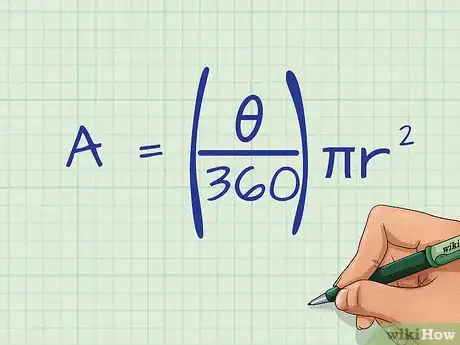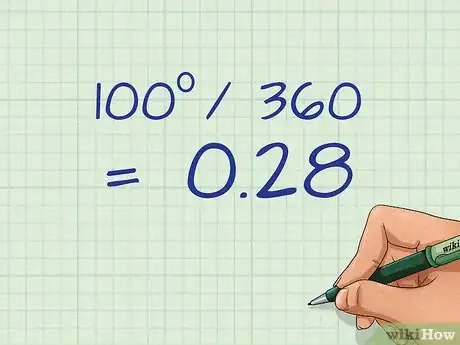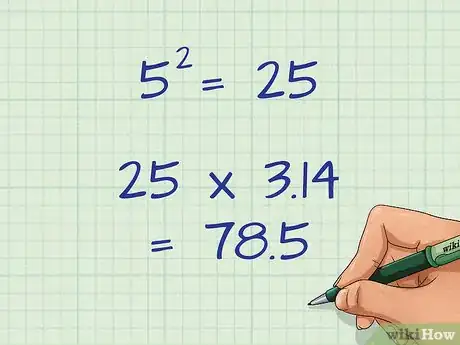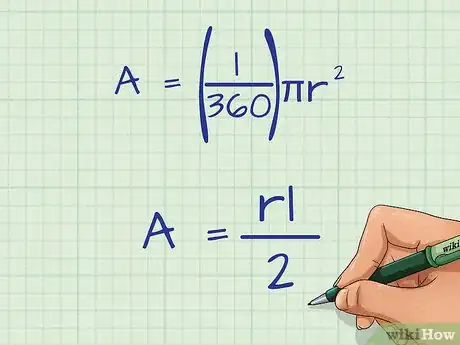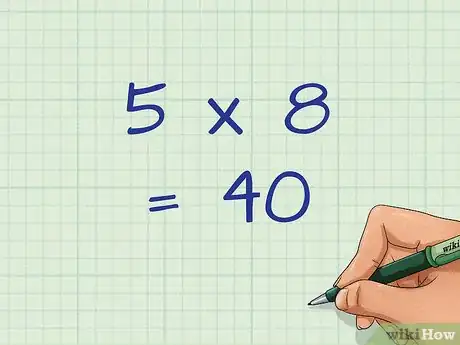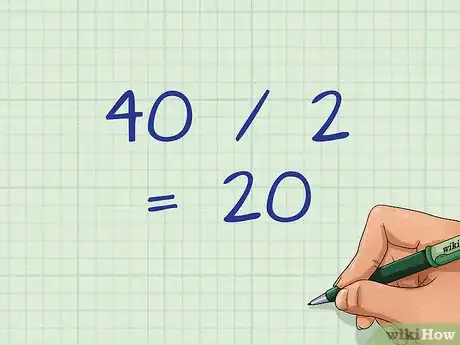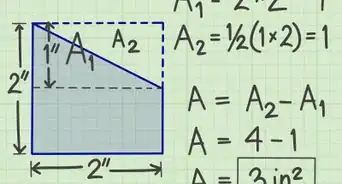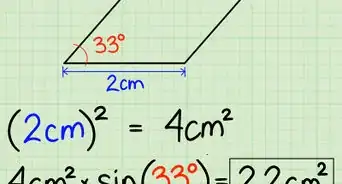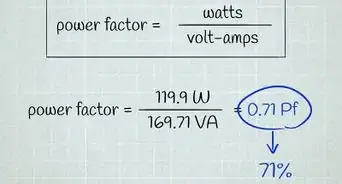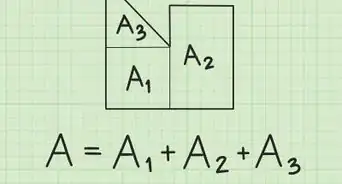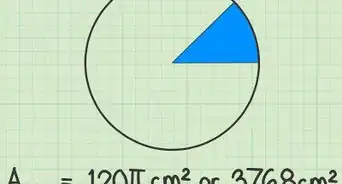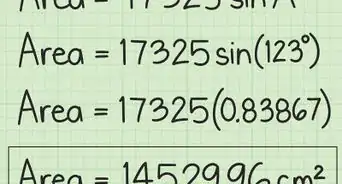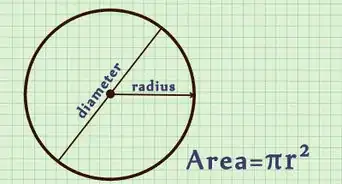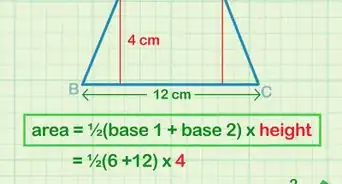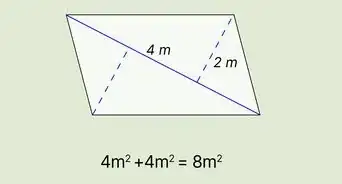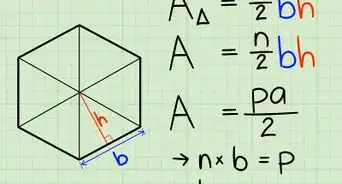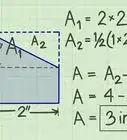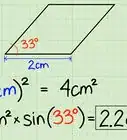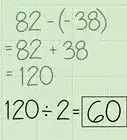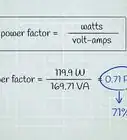This article was co-authored by wikiHow Staff. Our trained team of editors and researchers validate articles for accuracy and comprehensiveness. wikiHow's Content Management Team carefully monitors the work from our editorial staff to ensure that each article is backed by trusted research and meets our high quality standards.
This article has been viewed 189,444 times.
Learn more...
Sometimes you might need to determine the area of a sector, say for math questions or for a project you are working on. A sector is a part of a circle that is shaped like a piece of pizza or pie. To find the area of this piece, you need to know the radius, arc length and the degree of the central angle. With this information, finding the area of a sector is a simple matter of plugging the numbers into given formulas.
Steps
Calculating the Area with a Known Central Angle and Radius
-
1Set up the formula . In the formula, r = the length of the radius, and θ "Theta" = the degrees in the central angle of the sector.[1]
- Remember, the area of a circle is . When finding the area of a sector, you are really just calculating the area of the whole circle, and then multiplying by the fraction of the circle the sector represents.
- A circle is 360 degrees, so when you place the measurement of the sector's central angle over 360, it gives you the fraction of the whole circle.[2]
-
2Plug the sector's central angle measurement into the formula. Divide the central angle by 360. Doing this will give you what fraction or percent of the entire circle the sector represents.[3]
- For example, if the central angle is 100 degrees, you will divide 100 by 360, to get 0.28. (The area of the sector is about 28 percent of the area of the whole circle.)
- If you don't know the measurement of the central angle, but you know what fraction of the circle the sector is, determine the measurement of the angle by multiplying that fraction by 360. For example, if you know the sector is one-fourth of the circle, multiply 360 by one-fourth (.25) to get 90 degrees.
Advertisement -
3Plug the radius measurement into the formula. Square the radius, and multiply it by 𝝅 (3.14). Doing this will allow you to calculate the area of the whole circle.[4]
- For example, if the radius is 5 cm, you will square 5 to get 25, and then multiply 25 by 3.14, to get 78.5.
- If you don't know the length of the radius, but you know the diameter, simply divide the diameter by 2 to find the radius.
-
4Multiply the two numbers together. Again, you will be multiplying the percent by the area of the whole circle. This gives you the area of the sector.
- For example, 0.28 x 78.5 = 21.89.
- Since you are finding the area, the answer will be in square centimetres.
Calculating the Area with a Known Arc Length and Radius
-
1Set up the formula . In the formula, r = the length of the radius, and l = the length of the arc.
- Remember the formula for finding the circumference (perimeter) of a circle is 2𝝅r. If you know the length of the arc (which is a portion of the circumference), you can find what fraction of the circle the sector represents by comparing the arc length to the total circumference.
- The complete formula would be , but you can simplify it to .[5]
-
2Plug in the arc length and radius into the formula. You will be multiplying these two numbers to get a new numerator.[6]
- For example, if the arc length is 5 cm and the radius is 8 cm, your new numerator will be 40.
-
3Divide by 2. You are dividing the numerator found in step two. This gives you the area of the sector.
- For example, .
- Since you are finding the area, your answer will be in square centimetres.
Community Q&A
-
QuestionHow do I find the area of a sector if I know the diameter and the arc length?
 DonaganTop AnswererDivide the diameter by 2. That gives you the radius. Multiply the radius by the arc length, then divide by 2 again. That gives you the sector area.
DonaganTop AnswererDivide the diameter by 2. That gives you the radius. Multiply the radius by the arc length, then divide by 2 again. That gives you the sector area. -
QuestionHow do I find the angle of a sector if I have arch length and radius?
 DonaganTop AnswererDouble the radius, then multiply by pi. That gives you the circumference. Divide the length of the arc by the length of the circumference. That gives you the fraction of the circumference represented by the arc. Multiply that fraction by 360°. That gives you the central angle of the sector.
DonaganTop AnswererDouble the radius, then multiply by pi. That gives you the circumference. Divide the length of the arc by the length of the circumference. That gives you the fraction of the circumference represented by the arc. Multiply that fraction by 360°. That gives you the central angle of the sector. -
QuestionWhat is the area of a sector bounded by an arc of 60 degrees with a radius of 3 feet?
 DonaganTop AnswererAs shown above, the formula is (60°/360°) π (3)² = (1/6)(3.14159)(9). The area will be expressed in square feet.
DonaganTop AnswererAs shown above, the formula is (60°/360°) π (3)² = (1/6)(3.14159)(9). The area will be expressed in square feet.
References
- ↑ https://www.khanacademy.org/math/geometry-home/geometry-area-perimeter/geometry-perimeter/v/perimeter-and-area-basics
- ↑ https://www.youtube.com/watch?v=cAOVS2DTU0U
- ↑ https://www.youtube.com/watch?v=4BXMGuQdiBo
- ↑ https://www.youtube.com/watch?v=cAOVS2DTU0U
- ↑ https://www.mathopenref.com/arcsectorarea.html
- ↑ https://www.khanacademy.org/math/geometry/hs-geo-circles/hs-geo-sectors/v/area-of-a-sector-given-a-central-angle
About This Article
To calculate the area of a sector, start by finding the central angle of the sector and dividing it by 360. Next, take the radius, or length of one of the lines, square it, and multiply it by 3.14. Then, multiply the two numbers to get the area of the sector. For example, if the central angle is 100 degrees and the radius is 5, you would divide 100 by 360 to get .28. Then, square 5 to get 25 before multiplying it by 3.14 for an answer of 78.5. Finally, multiply .28 by 78.5 for a final answer of 21.89, which is the area of the sector. To learn how to calculate the area of a sector if you don’t know the central angle, read on!
